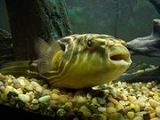
Fahaka pufferfish
Encyclopedia
The Fahaka pufferfish also known as the Nile puffer, Globe fish, Lineatus puffer (Tetraodon lineatus), is a tropical freshwater
pufferfish
found in the Nile river and other river basins of Africa
.
. Fahaka pufferfish, like other molluscivore
s, feed mainly on benthic organisms which may include mussels, cockles, oysters and krill
. They are typically found in large rivers, open water, weed beds and vegetated fringes in water ranging from 24°C - 26°C.
Freshwater
Fresh water is naturally occurring water on the Earth's surface in ice sheets, ice caps, glaciers, bogs, ponds, lakes, rivers and streams, and underground as groundwater in aquifers and underground streams. Fresh water is generally characterized by having low concentrations of dissolved salts and...
pufferfish
Pufferfish
Tetraodontidae is a family of primarily marine and estuarine fish of the Tetraodontiformes order. The family includes many familiar species which are variously called pufferfish, balloonfish, blowfish, bubblefish, globefish, swellfish, toadfish, toadies, honey toads, sugar toads, and sea squab...
found in the Nile river and other river basins of Africa
Africa
Africa is the world's second largest and second most populous continent, after Asia. At about 30.2 million km² including adjacent islands, it covers 6% of the Earth's total surface area and 20.4% of the total land area...
.
Characteristics
Fahaka pufferfish grow to around 43 cm (17-18"). Like all puffers they have the ability to inflate when threatened and carry the toxin TetrodotoxinTetrodotoxin
Tetrodotoxin, also known as "tetrodox" and frequently abbreviated as TTX, sometimes colloquially referred to as "zombie powder" by those who practice Vodou, is a potent neurotoxin with no known antidote. There have been successful tests of a possible antidote in mice, but further tests must be...
. Fahaka pufferfish, like other molluscivore
Molluscivore
A molluscivore is a carnivorous animal which eats mainly molluscs. The term durophagy is used to describe this eating behavior.Several species of pufferfish and loaches fit this category...
s, feed mainly on benthic organisms which may include mussels, cockles, oysters and krill
Krill
Krill is the common name given to the order Euphausiacea of shrimp-like marine crustaceans. Also known as euphausiids, these small invertebrates are found in all oceans of the world...
. They are typically found in large rivers, open water, weed beds and vegetated fringes in water ranging from 24°C - 26°C.

